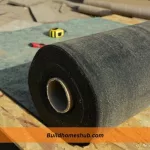When it comes to roofing, proper fastening is crucial for ensuring the durability and longevity of the structure. One of the most important decisions in the roofing process is deciding which type of fastener to use. Two of the most popular options are cap nails and staples.
While both have advantages and disadvantages, it ultimately comes down to personal preference and specific job requirements. In this article, we will take a closer look at the pros and cons of each option to help you make an informed decision.
Are Cap Nails Better Than Staples?
Yes, Cap nails are better, although it sometimes depends on the roofer’s specific job requirements and personal preference. Cap nails generally offer increased holding power, better wind uplift resistance, greater installation flexibility, and improved aesthetics. However, they are typically more expensive and require specialized tools and longer installation time.
On the other hand, staples have lower cost, faster installation time, can be used with various roofing materials and require fewer specialized tools. However, they have reduced holding power, greater risk of wind uplift, limited flexibility in installation and poorer aesthetics. Therefore, evaluating a project’s specific needs and the roofer’s preferences is important to decide which fastening method to use.
Comparing Cap Nails vs Staples
1. Holding Power
Cap nails have a higher holding power than staples. This is because cap nails have a larger surface area for the shingles to grip onto and are driven into the wood at an angle. In contrast, staples have a smaller surface area and are driven straight into the wood.
2. Wind Uplift Resistance
Cap nails offer better wind uplift resistance than staples. This is due to the larger surface area and angled installation of cap nails, allowing them better to hold down the shingles in high wind conditions.
3. Flexibility in Installation
Cap nails offer greater flexibility in installation as they can be used on various roofing materials such as asphalt, wood, and clay tiles. In contrast, staples are more limited and are typically used only with asphalt shingles.
4. Aesthetics/Cost
Cap nails have a cleaner look compared to staples as they are hidden under the shingles, while staples are visible. Cap nails are typically more expensive than staples.
5. Installation Time
Cap nails take longer to install than staples as they require specialized tools and more time for proper installation. Cap nails also require specialized tools for proper installation, which can be a disadvantage for some roofers
Advantages of Using Cap Nails
1. Increased holding power
Cap nails have a larger head size than staples, which allows them to distribute the weight of the roofing material more evenly. This results in a stronger and more secure hold, which can help to prevent shingle blow-offs and other issues.
2. Better resistance to wind uplift
Cap nails have a better ability to resist wind uplift than staples. This is because they create a larger surface area for the roofing material to adhere to, which reduces the chances of shingles or other materials lifting or moving during high winds.
3. Greater flexibility in installation
Cap nails can be used with various roofing materials, including asphalt shingles, metal roofing, and clay tiles. This allows for greater flexibility in the types of roofing projects that can be undertaken. Additionally, cap nails can be used in various weather conditions, including hot and cold temperatures.
4. Improved aesthetics
Cap nails have a more finished and professional look than staples. They are less visible on the roof, which can enhance the overall appearance of the finished product. Additionally, cap nails are more durable and resistant to rust, which can help prolong the roof’s life.
5. Increased Durability
The cap nails have a bigger head than staples and a larger surface area for the roofing material to be attached to. This larger surface area allows the cap nails to withstand more weight and pressure, making them more durable and long-lasting.
6. Better for Heavy-Duty Applications
Cap nails are often used in heavy-duty applications, such as commercial or industrial roofs, due to their increased holding power and resistance to wind uplift. They are often used for asphalt shingles, clay tiles and metal roofing, which need a stronger and more durable fastening method.
Disadvantages of Using Cap Nails
1. Higher cost compared to staples
Cap nails are generally more expensive than staples, which can be a disadvantage for roofing contractors or homeowners looking to save on material costs. The difference in cost can add up quickly, especially for larger roofing projects. Additionally, the specialized tools required for installation can add to the cost of using cap nails.
2. Longer installation time
Using cap nails generally takes longer than staples. This is because cap nails need to be inserted into the roof decking and bent over, which is more time-consuming than simply driving in a staple. This can be a disadvantage for roofing contractors looking to complete jobs quickly or for homeowners looking to minimise the time their roof is under construction.
3. Requires specialized tools
To properly install cap nails, roofers need specialized tools such as a cap nail gun, a hammer, and a cap nail punch. These tools can be costly and may not be available for purchase or rental. Additionally, roofers must be trained to use these tools properly to avoid injury and ensure proper installation.
4. Can be more difficult to install in certain roofing materials
Cap nails can be more challenging to install on certain roofing materials, such as metal roofs or composite shingles. This is because the cap nails need to be bent over and the material may not be flexible enough to allow this.
5. Can damage the roofing material
Cap nails can cause damage to the roofing material, such as cracking or splitting of the shingles, if not installed properly. This can reduce the overall lifespan of the roof, and may cause leaks. This risk is higher when installing cap nails on older or delicate roofing materials.
Advantages of Using Staples
1. Lower cost compared to cap nails
One of the major advantages of using staples for roofing is that they are generally less expensive than cap nails. This can be especially beneficial for larger roofing projects or those working within a tight budget. Additionally, staples can be purchased in bulk, further reducing the project’s overall cost.
2. Faster installation time
Another advantage of staples is that they can be installed much faster than cap nails. This is because staples are designed to be used with a pneumatic staple gun, which can shoot staples faster than manual installation with cap nails. This can greatly increase the efficiency of the roofing process, allowing for quicker completion of the job.
3. Requires fewer specialized tools
Staples also require fewer specialized tools than cap nails. A pneumatic staple gun is a primary tool needed for installation, which can be rented or purchased at a lower cost than specialized cap nail guns. This can be a more cost-effective option for roofers who do not frequently use cap nails.
4. Can be used with a variety of roofing materials
Another advantage of staples is that they can be used with a wide variety of roofing materials. This includes but not limited to asphalt shingles, metal roofing, tile roofing, and more. This versatility can be beneficial for roofers who work on a variety of different roofing projects and need to be able to adapt to different materials.
Disadvantages of Using Staples
1. Reduced holding power
One of the main disadvantages of using staples instead of cap nails is that they have reduced holding power. This means they may need to provide a different level of security and stability than cap nails. This can lead to issues such as shingle blow-offs or leaks, which can be costly and time-consuming.
2. Greater risk of wind uplift
Another disadvantage of staples is that they are more prone to wind uplift. This occurs when strong winds lift the shingles from the roof deck, causing damage or even complete failure of the roofing system. On the other hand, cap nails are designed to provide better resistance to wind uplift, making them a safer choice in areas prone to high winds.
3. Limited flexibility in installation
Staples are typically used with specific roofing material, such as asphalt shingles. This can limit the flexibility of the roofer in terms of the types of roofing systems they can install. Cap nails, on the other hand, can be used with various roofing materials, providing more versatility in installation.
4. Poorer aesthetics
Another disadvantage of using staples is that they can be quite visible on the roof, which can be unsightly. Cap nails, on the other hand, are hidden under the shingle tabs, providing a more polished, finished look to the roof. This can be especially important for residential roofs where aesthetics are a major concern.
Conclusion
Both cap nails and staples have their own set of advantages and disadvantages. Cap nails offer increased holding power, better resistance to wind uplift, and greater installation flexibility. However, they are more expensive and require specialized tools for installation. On the other hand, staples are more affordable and require fewer specialized tools, but they have lower holding power and are more prone to wind uplift.
The choice between cap nails and staples will ultimately depend on your specific roofing needs, budget, and personal preferences. It is recommended to consult with a professional roofing contractor or manufacturer for further guidance. Remember that proper fastening is crucial for ensuring the durability and longevity of the roofing structure.
I like to think I can help you with all the information you need on home renovations and DIY tips. You should subscribe.











